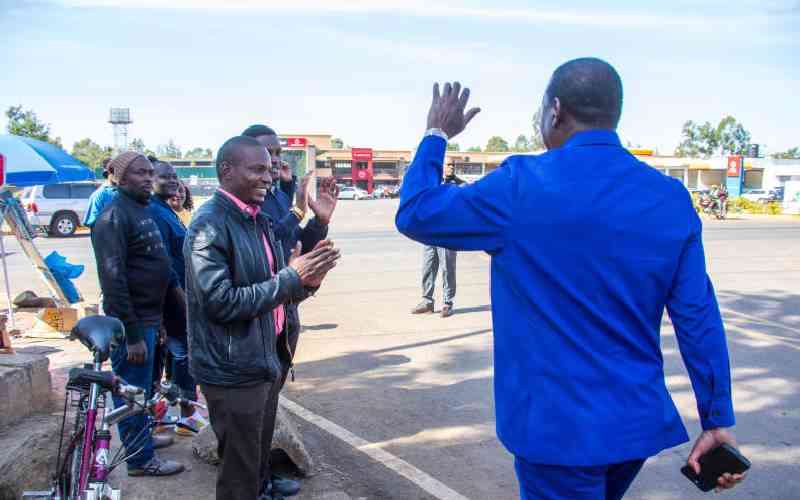
NAIROBI: November is celebrated the world over as Adoption Month.
As adoption agencies in Kenya await conclusion of talks with the Government regarding licensing, one man would like to focus his attention on the importance of formal adoptions.
Muteru Njama, the Managing Trustee of Change Trust, an organisation that deals with adoptions and children’s rights wishes more Kenyans would appreciate the purpose of formal adoptions.
“It is all about protecting the child’s welfare,” Njama says.
In many Kenyan communities, it is common to find one or more children being raised by people who are not their biological parents.
Such arrangements are more often than not informal and brought about by dire need - the child’s parent(s) could have died or they may be too poor to raise the child, or perhaps the children were saved from abuse and relatives who were more able or more responsible took them in.
Whatever the reason for taking children in, as long as it is a permanent arrangement then it is always better to have the adoption formalised. According to Njama, formal adoption is what guarantees protection of the children in question as well as the adults raising them.
“Adoption is all about making a new life,” he says, adding that when adoption is not formalised, children are left vulnerable to vices such as trafficking which he defines as any activity that results in children being moved from where they are to another place for financial benefit against the child’s best interests.
This means if a child is removed from the biological parents to live with and work for a relative who then sends money to the parents, that is classified as trafficking.
“Such an informal arrangement could also expose the ‘benefactor’ to blackmail from the child’s biological family, with the child getting caught in the middle,” he notes.
When adoption is formalised, the adopted child is considered part and parcel of the family and his or her interests are protected such as in the case of inheritance disputes. Formal adoptions also help to prevent cases of blackmail by the child’s biological relatives against the adoptive ones.
“When biological parents agree to a formal adoption, they are basically transferring all parental responsibility to the adoptive parents.
This means they cannot turn around and claim anything from either the child or the adoptive parents. Even people taking in a child who is related to them should go through formal adoption,” Njama advises.
Further, when an adoption is left informal, the adoptive parents have no claim on the child because no parental responsibility has been transferred. It also leaves the child vulnerable to possible exploitation.
Stay informed. Subscribe to our newsletter
Formal adoptions are just as important in the case of remarriage where there are children from previous relationships.
“The couple must do this together otherwise the child or children are once again left exposed. A formal adoption must state who will look after the child in the event of spousal death. If there is a will, the adopted child’s inheritance is secured and no court can reverse the adoption,” he says.
Who transfers parental responsibility to an adopter when a single parent dies? Njama says in this case, a death certificate is enough. A family member who wants to adopt the child will only have to present this document in court and it suffices to begin the formal adoption process.
Contrary to popular opinion, the adoption process is neither cumbersome nor expensive. According to Njama, children are released to adoptive parents within six weeks of starting the process. And within the year, the process should be complete.
“All this is provided for in the Children”s Act and is aimed at protecting the child,” he says.
Mary Wangari, a married mother of two adopted children, says formal adoption is an act of the will, not something done on a whim. So adopted children are assured of their place in the new family.
“Adopted children can rest in the knowledge that their parents committed themselves to this process despite the risks of negative influences from extended family and financial implications,” Mary says.
She continues: “Adoption is a good thing because it enables parents who are biologically unable to have children to be fully parents as opposed to taking in, for instance, a cousin’s baby. I am a mother today because these two children came to us through the adoption process”.
Mary and her husband adopted their children through the Child Welfare Society in the early and mid-1990s.
“It was a very thorough process. They even visited my parents-in-law to ascertain their consent. They also checked to see if the overall environment was okay for the children we were adopting that is, would they be accepted or rejected. It is all about protecting the child’s welfare,” she says.
Mary says she has no regrets about the process she and her husband followed. Everything was made very clear to them regarding their responsibilities as adoptive parents according to the law.
“It was a clear step by step process and the second time was easier hence faster because our first adoption was successful. I am glad we chose that route because we are covered by the law and have never had to look over our shoulders for fear of blackmail from anyone.
I would recommend formal adoption over a casual arrangement any day,” she says.
 The Standard Group Plc is a
multi-media organization with investments in media platforms spanning newspaper
print operations, television, radio broadcasting, digital and online services. The
Standard Group is recognized as a leading multi-media house in Kenya with a key
influence in matters of national and international interest.
The Standard Group Plc is a
multi-media organization with investments in media platforms spanning newspaper
print operations, television, radio broadcasting, digital and online services. The
Standard Group is recognized as a leading multi-media house in Kenya with a key
influence in matters of national and international interest.
 The Standard Group Plc is a
multi-media organization with investments in media platforms spanning newspaper
print operations, television, radio broadcasting, digital and online services. The
Standard Group is recognized as a leading multi-media house in Kenya with a key
influence in matters of national and international interest.
The Standard Group Plc is a
multi-media organization with investments in media platforms spanning newspaper
print operations, television, radio broadcasting, digital and online services. The
Standard Group is recognized as a leading multi-media house in Kenya with a key
influence in matters of national and international interest.









